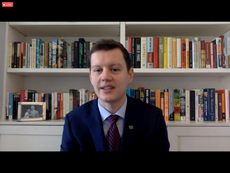
MEREDA economic overview: Inflation, consumer prices should level off
Eventual relief on interest rates should lead to a gradual recovery in real estate, even as the U.S. economy is likely to slow further over the next year and Congress engages in brinkmanship over the federal debt ceiling and a possible default by mid-2023.
That’s part of the economic forecast presented by James Marple, managing director and senior economist with TD Bank, during MEREDA's annual Real Estate Forecast Conference on Thursday.

Marple said inflation has slowed recently as global supply chain challenges have eased. Although higher interest rates have led to a sharp slowdown in real estate activity, overall economic data have remained resilient.
Overall, elevated inflation has prompted a strong response from global central banks.
The pandemic was a major challenge that changed where people worked and the demand for housing — especially true for Maine, which saw tremendous demand.
“That’s been a sea change from what had been a 20-year period of benign inflation,” said Marple.
Inflation rose at double-digit levels, and the U.S. Federal Reserve is trying to bring it down. Increased inhalation happened globally, not just in the U.S., due to the pandemic and disrupted global supply chains that resulted in a flare-up in prices, which first took place in the cost of goods.
The start of 2022 saw another major shock with the Russian invasion of Ukraine, leading to a spike in energy prices. That’s influenced inflation in North America and, more so, in Europe due to the latter’s dependence on natural gas coming from Russia.
Inflation in North America has peaked and is starting to retreat, Marple said. Through 2022, the cost of goods started to come down and is beginning to normalize, he said. Commodity prices remain elevated, especially in the energy sector. Core goods prices, excluding energy, have started to come down, especially in the final three months of 2022. That’s a good sign and could continue through 2023, said Marple.
Shelter prices, including rents — which are a major driver of the cost of shelter — are still accelerating, although not as quickly, said Marple. That will likely contribute to inflation.
“But we’ve seen signs that market rents have started to slow as we see overall housing demand slow as interest rates have risen,” Marple said.
Higher interest rates are affecting the economy, said Marple. That’s most evident in the housing market, which surged nationally and even more so in Maine, where the surge in sales saw double-digit gains in 2021.
However, the surge of sales peaked in mid-2022 as interest rates began to decline; sales fell through the second half of the year. That’s led to a slowing in the rate of home price growth. Marple said he anticipates that prices will continue to pull back as demand for affordability grows.
Some of that spending, he noted, is because people weren’t able to spend at typical levels during the pandemic. And income support provided by the federal government resulted in higher income levels that people wouldn’t have had if the pandemic hadn’t occurred. As a result, the population accumulated $2.5 trillion in savings, which is now starting to be drawn down, partly as inflation eats into purchasing power.
“We expect that could continue over 2023,” said Marple. “But there are other reasons people have saved, so I wouldn’t necessarily expect this to go zero.”
Overall, markets were relatively healthy through the pandemic until 2022, when interest rates started to go up. Solid household balance sheets should provide some resilience to the spending outlook, given the purchasing power issues and higher interest rates, he said.
The real challenge, he said, is to get inflation down from 9% at its peak to 4% and even to the 2% mark.
During the pandemic, there was an unprecedented increase in the rate of job openings that went unfilled. That was especially true in Maine, where there were at least two job openings per unemployed person. The tight labor market resulted in increased wage growth. The rate of wage growth is now starting to slow.
However, there is still a shortage of workers. Maine’s labor force is 4% to 5% below where it was before the pandemic.
“The workforce is aging and people are retiring and the pandemic probably sped that up,” said Marple.
Maine’s participation rate in the job market is at an all-time low, which likely reflects the state’s aging demographic.
“That’s not a challenge that’s going to go away,” said Marple.
There’s little growth in the under-55 population nationally and even more so in Maine. Only by bringing new people into the state will the state see any growth in the population.
Maine needs 5,000 to 6,000 people to migrate in annually or the state’s population will begin to decline over the next five years.
“That’s a challenge to the labor force” both near term and longer term, he said.
But the good news is that Maine has seen good signs of positive in-migration.
“If that can increase a little more there’s the potential for growth,” he said.
The consequence of slowing economic activity as a result of higher interest rates has been evident in purchases of housing and other large expenditures such as cars.
“We expect to see some recovery taking place in late 2023 and into 2024,” he said.
It’s expected the Federal Reserve will maintain interest rates above 5% well into 2023, with a decline expected to start by late 2023 and into 2024.
The economy today doesn’t show signs of being in recession yet, “although the warning signals are there,” said Marple.
“We’re still in pretty good condition,” he added.
A major risk, however, is the issue around raising the debt ceiling, the risk of default, and the Congressional “brinkmanship” that surrounds the issue. The last time the issue arose was in 2011. At that time, the ceiling was raised before there were missed payments. But the U.S. economy did see a tightening of financial conditions and slowed economic activity.
“We can’t make a firm prediction on that,” said Marple.












0 Comments